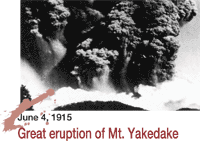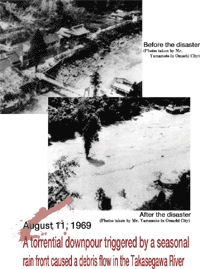
| 1584 - | Great eruption of Mt. Yakedake. The Nakao Pass exploded, and a debris flow flowed down all the way to the Kamisaka district from the crater. |
| 1735 - | A landslide occurred on the east side of Waritani volcano. The gExtrusionh was formed near Kamikochi spa. |
| 1746 - | Mt. Yakedake erupted, and a great earthquake hit the country. |
| 1757 - | Mt. Togihata collapsed, and stopped water for two days; then, it flowed out all at once, and caused a great deal of disaster to the lower reaches. |
| 1802 - | Kakunodaira was devastated. Landslides buried six houses. |
| 1887 - | Myosaizeki dam was breached, and a large collapse occurred. |
| August 23, 1890 - | A great flood occurred in the Azusagawa River. |
| 1896 - | A collapse of Mt. Mukai at Kakunodaira in Nagawa Village occurred. Six
houses were buried. Twelve lives were lost. Matsumoto suffered a great flood damage. |
| July 15, 1902 - | A flood occurred in the Himekawa River. Mt. Kozuchi in Minamiotari Village collapsed. |
| 1909 - | Mt. Yakedake erupted dozens of times. |
| August 11, 1910 - | A flood damage was caused by the Takasegawa River and the other small rivers. A flood in the Himekawa River caused a flood damage to the whole area along the river. |
| August 8, 1911 - | A great collapse of Mt. Hieda occurred, which dammed up the Hime-kawa River. |
| July 22, 1912 - | A great torrential downpour caused damage to the whole area along the Himekawa River. |
| June 4, 1915 - | Taisho Pond appeared upon great eruption of Mt. Yakedake. |
| July 9, 1917 - | A deluge in the Matsukawa River and the Hirakawa River caused a great deal of damage. |
| April 1923 - | A torrential downpour caused a flood to the Himekawa River. The Kuruma district was washed away by the flood. |
| August 20, 1924 - | Two places of the embankment in the site of Nechimura Village broken. A flood washed away the area for about 130 hours. |
| July 9, 1931 - | A deluge in the Matsukawa River and the Hirakawa River caused a great deal of damage. |
| July 11, 1934 - | An embankment in the Hirakawa River collapsed, and caused a great deal of flood damage to the Kitashiro district. |
| May 23, 1936 - | A thaw collapsed Mt. Kazefukidake. Debris flows occurred for three days. |
| June 28, 1936 - | An embankment in the site of Ueno in Nechimura Village was broken by some 150m. |
| April 21, 1939 - | Mt. Kazehari in Minamiotari Village collapsed, and dammed up the Himekawa River. |
| 1945 - | An autumn rain front and a typhoon caused a great deal of flood damage to Nakawa Village. |
| October 3, 1945 - | A debris flow hit Shimashimadani. |
| June 1946 - | The Hirakawa River and the Matsukawa River flooded after the torrential downpour. |
| June 29, 1946 - | A landslide occurred near Kuruma and Johoji. |
| July 28, 1948 - | A thunderstorm caused a debris flow to flow out of Mt. Kazefukidake, and dammed up the Himekawa River. |
| September 26, 1953 - | A Koyanai embankment in Nechimura Village was broken by 60m. |
| July 10, 1959 - | The Hirakawa River and the Matsukawa River flooded. The total amount of damage reached 45 million yen. Service on the Oito Line was suspended. |
| September 26, 1959 - | Typhoon No. 15 collapsed the Matsukawa embankment. |
| June 23, 1961 - | A seasonal rain forest caused a great mud avalanche to hit Zenrokuzawa. |
| June 17, 1962 - | Mt. Yakedake erupted. |
| 1963 - | The areas along the Azusagawa River and the Honkawa River were inundated by the flooding after the localized torrential downpour. |
| July 7, 1964 - | A seasonal rain front caused the Nechigawa River to flood. The amount of damage reached 180 million yen. |
| August 29, 1964 - | A debris flow occurred in Urakawa. Aggradation occurred by 12 to 20m. The Himekawa River and the Honkawa River were dammed up, which caused a great deal of damage. |
| May 8, 1965 - | A landslide occurred in the upper reaches of the Urakawa River, and dammed up the Himekawa River and the Honkawa River. Service on the Oito Line was suspended. The bridges were washed away. |
| July 13, 1965 - | The Nechigawa River flooded after the localized torrential downpour. The amount of damage reached 260 million yen. |
| September 18, 1965 - | Typhoon No. 24 hit the drainage area of the Nechigawa. The amount of damage reached 2.2 billion yen. |
| 1966 - | A mud avalanche occurred in the Urakawa River. |
| 1967 - | A great landslide collapse of Mt. Akahage in the Odokorogawa River caused a great deal of damage. |
| August 9, 1969 - | A localized torrential downpour caused a flood. The amount of damage to the basin area of the Nechigawa River reached 490 million yen. |
| August 11, 1969 - | A great flood of the Takasegawa River was caused by an autumn rain front.
The flood submerged Kuzu spa. |
| July 3, 1975 - | A debris flow hit Hachiemonsawa and Shirosawa after the localized torrential downpour. |
| June 19, 1978 - | A mud avalanche caused by an autumn rain front hit Genmonsawa, Zenrokusawa, and Shirosawa. |
| June 26, 1978 - | A flood caused by a torrential downpour collapsed the Suishingu bridge in Hakubamura Village. |
| August 23, 1979 - | Typhoon No. 11 caused debris flow to occur in Kamikochi. A debris flow occurred in the Urakawa River, too. |
| May 12, 1981 - | A large-scale debris flow occurred in the Urakawa River, and arrived all the way at the Himekawa River. |
| June 23, 1981 - | The Himekawa River was swollen, and collapsed the Otari bridge. |
| August 23, 1981 - | typhoon No. 15 caused a sediment-related disaster to Nigorizawa, Shiraisawa, and the Nakamatagawa River. |
| September 28, 1983 - | A localized torrential downpour occurred in Nagawa Village because of typhoon No. 10. The amount of damage reached 5.6 billion yen. |
| March 8, 1991 - | A large-scale landslide occurred in Hisui valley. |
| October 18, 1991 - | A landslide occurred near Sarunagidomon in the Azusagawa River. |
| April 8, 1992 - | A large-scale debris flow occurred in the Urakawa River. The sabo dam stopped it. |
| July 11, 1992 - | A localized torrential downpour triggered by a seasonal rain front caused damage one after another to the area centering on Otari Village and Itoigawa City. The Oito Line was hit hard. |
| December 6, 1996 - | A collapse in the upper reaches of Gamaharazawa caused a debris flow. Fourteen lives were lost. Nine people were injured. |
| September 15, 1999 - | An erosion collapse at the exit of Kama tunnel of the Prefectural Route
Kamikochi-koen isolated 1,300 people. |
 |
||
|
||
 |
||
|
||